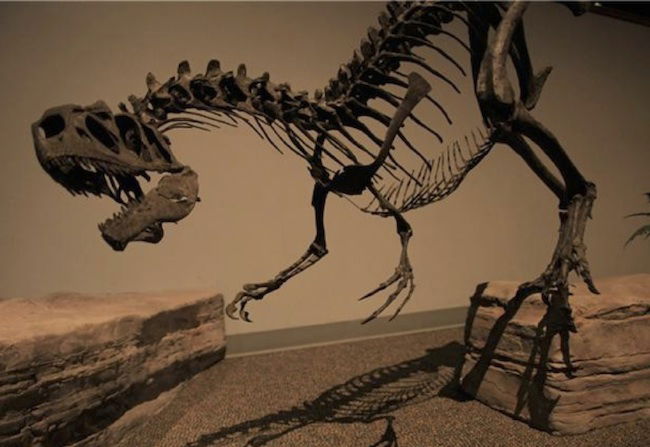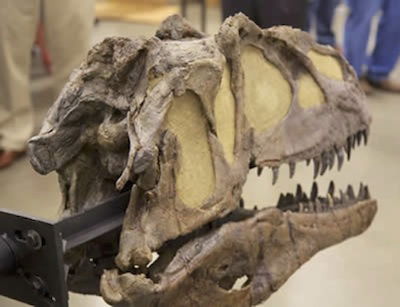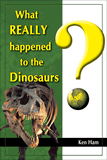
Broken Toes and Strained Hypotheses in Fractured Allosaurus Tale
News to Know
Abstract
Trace elements in theropod toe show bone-healing physiology is unchanged since dinosaurs walked the earth.
News Source
- Sci-News.com: New Research Sheds Light on Dinosaur Bone Healing
“Chemical ghosts” in a healing Allosaurus toe fracture show the dinosaur’s bone healed the same way as bones in modern vertebrates. Because they believe 150 million years of evolutionary change separates the Allosaurus from us, evolutionary paleontologists are surprised.
“It’s remarkable that the very same chemistry that initiates the healing of bone in humans also seems to have followed a similar pathway in dinosaurs,” says Phillip Manning, senior author of the report published in the Journal of the Royal Society Interface.
Broken Toes
Manning’s team compared the dinosaur toe to a turkey vulture’s due to the popular but biblically and biologically untenable belief that birds evolved from dinosaurs. The Royal Society newsletter explains, “The researchers hope to shed light on how dinosaurs compare to their existing relatives.”1
The dinosaur’s fracture had healed better than the bird’s. Manning speculates the Allosaurus fracture healed more like a modern crocodilian’s fracture than a modern bird’s because birds lost some of their ability to heal effectively2 when they evolved hollow bones.3 Since there is no way to know how long the dinosaur had been healing, its age or nutritional state, the integrity of its immune system, or any number of other factors that ordinarily affect bone healing efficiency, attributing the difference to the bird’s divergence from its supposed evolutionary forebear is a bit of a stretch, an example of ignoring the obvious to grasp at an evolutionary straw.
“This is the starting point in a new line of research that has a long way to go when comparing the chemistry of bone between species, both modern and extinct. We are already looking at new techniques that might further expand our understanding of the growth, trauma and healing of bones in vertebrates,”4 Manning says. “It seems dinosaurs evolved a splendid suite of defence mechanisms to help regulate the healing and repair of injuries. Not a lot is known about the biochemistry of healing in extinct animals. So, the ability to diagnose such processes some 150 million years later might well shed light on how we can use Jurassic chemistry in the 21st century.”5

This Allosaurus was nursing a fractured toe when it died. Healing was progressing nicely and following the same pattern as fracture-healing physiology in modern vertebrates including humans. Image by Phil Manning, via ScienceDaily.

This is a thin section of the Allosaurus toe seen with ordinary optical imaging (top) and a trace element synchrotron-generated map of elemental iron (bottom). The thickened callus of the healing fracture is seen at the top and bottom of the section (labeled major and minor callus). Iron is heavily concentrated (hence darker) in the normal bone layers near each callus and also adjacent to the medullary cavity where bone is being resorbed and remodeled. Image by J. Anné et al., via Journal of the Royal Society Interface.
Jurassic Chemistry
Paleontologists combined modern imaging techniques to identify trace metals incorporated into a healing toe fracture on an Allosaurus fragilis from North America’s Morrison Formation. They demonstrated that the patterns left by the minerals in the thickened callus are consistent with minerals deposited during the healing of a vertebrate fracture rather than with minerals deposited during fossilization.
New Allosaurus Exhibit at the Creation Museum

We are pleased to announce the addition of a world-class dinosaur skeleton, an
“It is a fine line when diagnosing which part of the fossil was emplaced after burial and what was original chemistry to the organism,” explains coauthor Roy Wogelius. “It is only through the precise measurements that we undertake at the Diamond Synchrotron Lightsource in the UK and the Stanford Synchrotron Lightsource in the US that we were able to make such judgments.”6
A synchrotron is a particle accelerator. The techniques used to study the toes included synchrotron rapid scanning X-ray fluorescence and microfocus elemental mapping. Together they provided a highly sensitive, high-resolution method to map “the distribution and concentration of trace elements within pathological and normal bone.”7
“You can only detect such chemistry using a synchrotron,” Manning explains, “because this technique permits you to exactly image the relationship of each atom to its surrounding elements. This allows you to identify if the element was part of the bone-healing process, or if it came from the environment in which the bone was fossilized.”8
Pinpointing the Bone-Repair Process
The paleontologists were looking for copper, zinc, and strontium in the bone.9 “This is because the body uses a distinct suite of trace-metal co-ordinated enzymes to repair bones,” Manning explains. “Copper-based enzymes are associated with forming calluses. The second stage of bone repair involves zinc-containing enzymes, which promotes bone growth. And the final stage to check all the work done is good involves an enzyme that contains strontium. So if you’re imaging a healed fracture, you’ll find trace amounts of strontium evenly distributed along the healed bone. But if it’s still healing, there’ll be higher concentrations of zinc.”10 The spatial distribution of trace elements is known to vary in healing fractures in humans,11 providing a basis for these comparisons.
Trace element patterns were the same in the extinct dinosaur and the modern bird. They were, not surprisingly, also the patterns expected for any vertebrate, reflecting not common evolutionary ancestry but the bone-healing process designed by our common Designer, God.
Zooming in on Zinc
Zinc concentrates in immature, woven bone tissue while it is being remodeled, and that was found in the Allosaurus toe callus. The distribution of zinc in the Allosaurus toe showed bone was still being laid down at the fracture site when the animal died. Furthermore, iron tends to accumulate between a callus and normal bone, and in the Allosaurus toe, iron was concentrated there. Thus the researchers were confident that the fracture was actively being ossified at the time of the dinosaur’s death. The trace metal distribution also outlined the microstructure of the healing bone better than optical imaging alone could do. Strontium and copper were still distributed evenly between the callus and normal bone in each toe, pinpointing the phase of healing. As a bonus, bone maps of trace elements like strontium reveal textural details in fossilized bone that cannot be easily seen using ordinary optical microscopy.
But how do the researchers know that trace metals like zinc were not simply a contaminant of the fossilization process? These paired techniques detect the arrangement of the zinc atoms. The geometry was consistent with that seen when it is associated with organic hydroxyapatite. If the zinc had permeated the bone during fossilization, zinc atoms would have been coordinated with inorganic minerals and assumed a different arrangement.
This sophisticated research may provide a way to use trace elements to track the healing of ancient fractures and even to get clues about embryonic skeletal development in extinct animals, but it does not track evolutionary pathways.
Bone Repair Recapitulates Embryonic Development
It may be possible to understand the embryonic development of extinct animals by studying healed fossil fractures using these techniques.
“The chemistry of life leaves clues throughout our bodies in the course of our lives that can help us diagnose, treat and heal a multitude of modern-day ailments,” says Manning. “Bone does not form scar tissue, like a scratch to your skin, so the body has to completely reform new bone following the same stages that occurred as the skeleton grew in the first place,” explains co-author Jennifer Anne. “This means we are able to tease out the chemistry of bone development through such pathological studies. It’s exciting to realize how little we know about bone, even after hundreds of years of research. The fact that information on how our own skeleton works can be explored using a 150-million-year-old dinosaur just shows how interlaced science can be.”
Much remains to be learned about fracture healing, even in mammals, but the complex, well-orchestrated process of bone regeneration largely recapitulates embryonic bone development. This includes grossly obvious steps such as intramembranous ossification (direct ossification), endochondral ossification (ossification of a cartilage template), and bone remodeling. Even at the molecular level, bone healing follows the patterns seen in embryos. Several cell types coordinate with each other as they differentiate and proliferate to repair and replace each part of the bone in the same way they do during embryonic skeletal formation.12
Thus it may be possible to understand the embryonic development of extinct animals by studying healed fossil fractures using these techniques. This of course has nothing to do with evolution of more complex kinds of animals since embryologic development tells how a species of animal develops, not how it changes into something new and different.
Comparative Anatomy Versus Strained Hypotheses
Finding the same bone healing physiology in vertebrates extant and extinct is really no surprise, since all—dinosaurs, birds, crocodiles, and humans—were designed by the same Creator about 6,000 years ago. Bone healing did not have to evolve but was graciously provided by God. Our Common Designer created a great way for bones broken in this sin-cursed world to heal. It is no surprise that He placed the same repair physiology in many different kinds of animals and humans.
Allosaurus Exhibit
An adult Allosaurus, found in 2001–2002 in the Morrison Formation with its bones in their correct anatomical positions, will go on display this Memorial Day weekend at the Answers in Genesis Creation Museum. The 34-inch long, 22-inch tall skull is 97 percent complete. It has 53 curved, serrated teeth averaging 4.5 inches in length. Of the 60 Allosaurus specimens worldwide, only a half-dozen have such a complete skull. The neck vertebrae were still attached to it when it was found and, unusually, the hyoid bone was even preserved.
In a few months, according to Answers in Genesis geologist Dr. Andrew Snelling, “We will start CT scans of the bones, so then we will know if he suffered any trauma, apart from having his skull slightly crushed, probably on burial when his neck was also broken.” A site study to ascertain how he likely died and was buried is also underway, and results will be published in the peer-reviewed Answers Research Journal.
Nicknamed “Ebenezer,” this Allosaurus met his end during Noah’s Flood about 4,300 years ago. He likely tried to flee the violently rising waters surging over the land where he lived, and was finally swept away and rapidly buried beneath tons of water-borne sediment, explaining the practically undisturbed arrangement of so many of his smaller bones. Ultimately he and every air-breathing animal not on the Ark with Noah died (Genesis 7:22). Biblical history gives us a context for this dinosaur’s death and preservation in the Jurassic portion of the fossil record.
We encourage you make your plans to visit the Creation Museum and see the new Allosaurus exhibit, opening Memorial Day weekend.
Further Reading
- Do Tacked-on Chicken Tails Tell How T-rex Walked?
- Did Dinosaurs Turn into Birds?
- World-Class Dinosaur Donated to the Creation Museum
- Triceratops Tally up to Four in New Wyoming Dinosaur Graveyard
- Dinosaur National Monument: Jurassic Park Or Jurassic Jumble? (ICR)
- Mapping Out the Truth
- The Extinction of the Dinosaurs
- The Key to the Age of the Earth
For More Information: Get Answers
Remember, if you see a news story that might merit some attention, let us know about it! (Note: if the story originates from the Associated Press, FOX News, MSNBC, the New York Times, or another major national media outlet, we will most likely have already heard about it.) And thanks to all of our readers who have submitted great news tips to us. If you didn’t catch all the latest News to Know, why not take a look to see what you’ve missed?
(Please note that links will take you directly to the source. Answers in Genesis is not responsible for content on the websites to which we refer. For more information, please see our Privacy Policy.)
Footnotes
- Jennifer Anne et al., “Dino Bones Give Clues to Brutal Life,” Royal Society Open Science, May 7, 2014, royalsociety.org/news/2014/dino-bones-hide-chemical-clues.
- Some aspects of bird bone healing differ from other vertebrates, and this may be associated with the fact that God designed them to be hollow, but that has nothing to do with evolution.
- “Dino, Heal Thyself: Giant Beast Had Power to Shrug Off Bone Trauma,” FOX News, May 7, 2014, www.foxnews.com/science/2014/05/07/dino-heal-thyself-giant-beast-shrugged-off-bone-trauma.
- Ibid.
- “High-Resolution Images Shed Light on Dinosaur Bone Healing,” Geology Page, May 28, 2014, http://www.geologypage.com/2014/05/high-resolution-images-shed-light-on-dinosaur-bone-healing.html.
- Manchester University, “Revealing the Healing of ‘Dino-Sores”: Examining Broken Bones in 150-Million-Year-Old Predatory Dinosaur,” ScienceDaily, May 6, 2014, www.sciencedaily.com/releases/2014/05/140506190620.htm.
- J. Anné et al., “Synchrotron Imaging RevealsBbone Healing and Remodeling Strategies in Extinct and Extant Vertebrates,” Journal of the Royal Society Interface 11, no. 96 (May 7, 2014): doi:10.1098/rsif.2014.0277.
- “High-Resolution Images Shed Light on Dinosaur Bone Healing.”
- Copper concentrates in healing fractures because it is associated with the molecular cross-links that form in collagen. Zinc tends to concentrate in areas of active ossification, particularly in woven bone not yet remodeled. Strontium increases osteoblast activity and decreases osteoclast activity and is therefore associated with bone deposition. Furthermore, the distribution of zinc and iron differs according to the type of bone tissue. From J. Anné et al., “Synchrotron Imaging Reveals Bone Healing and Remodeling Strategies in Extinct and Extant Vertebrates.”
- “High-Resolution Images Shed Light on Dinosaur Bone Healing.”
- B. Pemmer et al., “Spatial Distribution of the Trace Elements Zinc, Strontium and Lead in Human Bone Tissue,” Bone 57, no. 1 (November 2013): 184–193, doi:10.1016/j.bone.2013.07.038.
- R. Dimitriou et al., “Current Concepts of Molecular Aspects of Bone Healing,” Injury: International Journal of the Care of the Injured 36, no. 12 (December 2005): 1392–1404, doi:10.1016/injury.2005.07.019.
Recommended Resources

Answers in Genesis is an apologetics ministry, dedicated to helping Christians defend their faith and proclaim the good news of Jesus Christ.
- Customer Service 800.778.3390
- © 2024 Answers in Genesis




